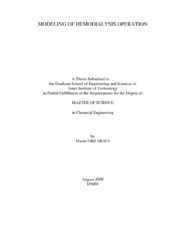Please use this identifier to cite or link to this item:
https://hdl.handle.net/11147/3926Full metadata record
| DC Field | Value | Language |
|---|---|---|
| dc.contributor.advisor | Alsoy Altınkaya, Sacide | - |
| dc.contributor.author | Abacı, Hasan Erbil | - |
| dc.date.accessioned | 2014-07-22T13:52:43Z | - |
| dc.date.available | 2014-07-22T13:52:43Z | - |
| dc.date.issued | 2008 | - |
| dc.identifier.uri | http://hdl.handle.net/11147/3926 | - |
| dc.description | Thesis (Master)--Izmir Institute of Technology, Chemical Engineering, Izmir, 2008 | en_US |
| dc.description | Includes bibliographical references (leaves: 82-91) | en_US |
| dc.description | Text in English; Abstract: Turkish and English | en_US |
| dc.description | xiii, 91 leaves | en_US |
| dc.description.abstract | Recent studies have shown that the effectiveness of hemodialysis is based on module geometry, membrane properties and operating conditions. Various experimental work exist in the literature concentrated on the synthesis of new hemodialysis membranes. However, optimization of membrane structure requires extensive and time consuming experimentations. Therefore, mathematical models are neccessary that can be used to predict the performance of hemodialysis operation. In this study, a predictive theoretical model was developed to predict the solute concentrations in patient.s blood and optimize the efficiency of hemodialysis operation. The model takes into account simultaneous mass and momentum transfer along with the adsorption of rejected protein molecules on the surface of the membrane.Model predictions show that blood and dialysate flowrates are effective for all sizes of molecules. The change in structural properties of the membrane makes no effect on the total removal of urea beacause of its high clearance. On the other hand, a considerable increment in the clearance of larger molecular weight solutes occurs as the pore size and porosity of the membrane increases. The most important design parameter for dialysis unit which influence the solute clearances significantly is found to be the effective diameter among the fibers in the dialyzer.The model is extended to investigate the use of urease immobilized membranes on the efficiency of the hemodialysis operation. The results have shown that urease immobilization enhances the removal of urea from the blood and decreases the protein adsorption capacity of the polysulfone membrane.Model predictions are compared with different sets of clearance data available in the literature. The agreement is found to be satisfactory which suggests that the model can be used as a tool to design or test the performance of dialysis units. | en_US |
| dc.language.iso | en | en_US |
| dc.publisher | Izmir Institute of Technology | en_US |
| dc.rights | info:eu-repo/semantics/openAccess | en_US |
| dc.subject.lcc | RC901.7.E53 A116 2008 | en |
| dc.subject.lcsh | Hemodialysis | en |
| dc.subject.lcsh | Hemodialysis--Mathematical models | en |
| dc.subject.lcsh | Blood--Filtration | en |
| dc.title | Modeling of Hemodialysis Operation | en_US |
| dc.type | Master Thesis | en_US |
| dc.institutionauthor | Abacı, Hasan Erbil | - |
| dc.department | Thesis (Master)--İzmir Institute of Technology, Chemical Engineering | en_US |
| dc.relation.publicationcategory | Tez | en_US |
| dc.identifier.wosquality | N/A | - |
| dc.identifier.scopusquality | N/A | - |
| item.languageiso639-1 | en | - |
| item.openairetype | Master Thesis | - |
| item.cerifentitytype | Publications | - |
| item.openairecristype | http://purl.org/coar/resource_type/c_18cf | - |
| item.fulltext | With Fulltext | - |
| item.grantfulltext | open | - |
| Appears in Collections: | Master Degree / Yüksek Lisans Tezleri | |
Files in This Item:
| File | Description | Size | Format | |
|---|---|---|---|---|
| T000713.pdf | MasterThesis | 894.16 kB | Adobe PDF |  View/Open |
CORE Recommender
Page view(s)
402
checked on Jul 7, 2025
Download(s)
300
checked on Jul 7, 2025
Google ScholarTM
Check
Items in GCRIS Repository are protected by copyright, with all rights reserved, unless otherwise indicated.